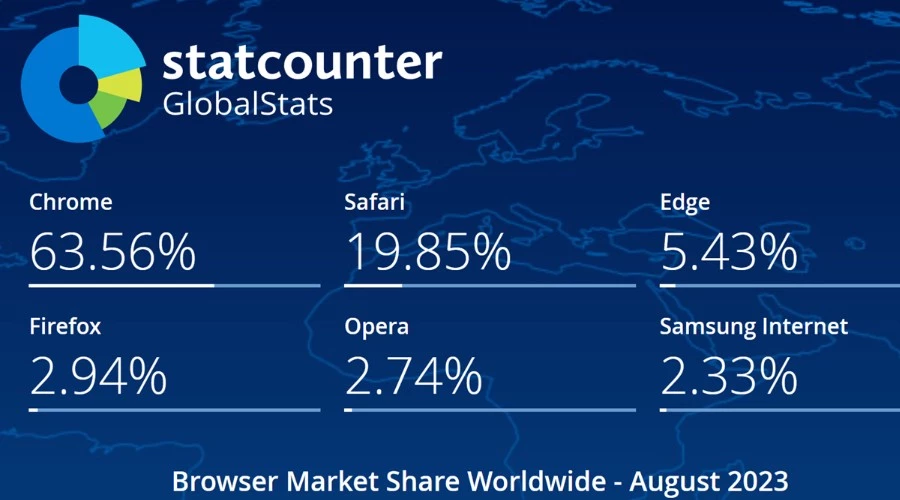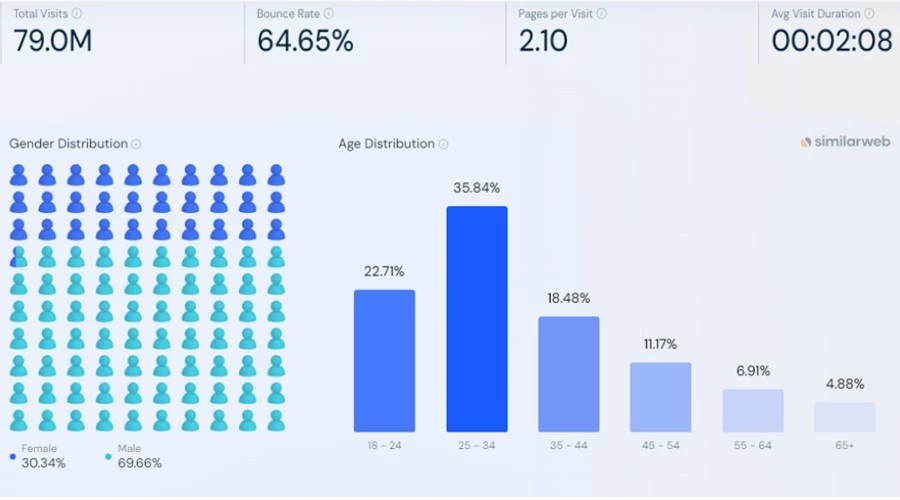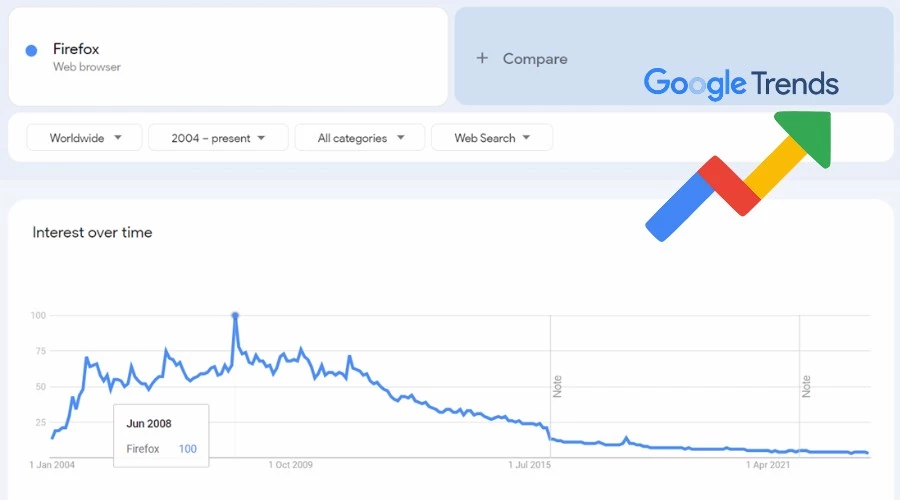21 Fascinating Firefox Statistics You Did Not Know About
9 min. read
Updated on
Read our disclosure page to find out how can you help MSPoweruser sustain the editorial team Read more

First released in 2004, Mozilla Firefox quickly became the go-to alternative to Internet Explorer and other aging web browsers. Today, it remains in the top 4 and has carved out a niche for loyal users.
In these fascinating Firefox statistics, you will learn about its market share, user base, historical milestones, and more.
Key Firefox Statistics Everyone Should Know in 2023
Digging into the vast data, these are the most important stats that shed light on Firefox’s current place in the web browser landscape and some shocking facts that might leave you scratching your head.
- Firefox is the 4th most popular web browser in the world, surpassing Opera in August 2023.
- Between 180 and 175 million people actively use Firefox every month.
- Users spend an average of 5 hours a day on Firefox.
- Firefox’s most popular year was 2010.
- In its first year Firefox received over 100 million downloads.
- Mozilla reported revenues of $600 million in 2021.
Firefox Statistics and Market Share
How much of the web browser pie goes to Firefox? In which regions is it most popular, and do its users prefer desktop or mobile? Here’s how it stacks up against Chrome, Edge, and others.
1. Firefox is the 4th most popular web browser in the world, surpassing Opera in August 2023.
(Source: StatCounter Browser Market)
Based on the latest data from August 2023, Firefox has surpassed Opera to become number four in the global web browser market. This is represented by a 2.94% share of the market, compared to Opera’s 2.74% share.
Ahead of Firefox is Microsoft Edge with 5.43%, Apple Safari with 19.85%, and Google Chrome dominating with a 63.56% market share.
2. Between 180 and 175 million people actively use Firefox every month.
(Source: Firefox Data)
Firefox is one of the few that publicly share its browser usage data every week. Based on these figures, the browser currently has between 180 and 175 million active users in August 2023.
Firefox’s most popular months this year were between February and March, averaging over 252 million users.
3. Firefox is most popular in Europe and least popular in Asia.
(Source: StatCounter Browser Market)
Market share varies by region. Europe has the most Firefox users, which equates to 5.55% of the global browser market, and fourth behind Edge, Safari, and Chrome.
However, in Asia Firefox doesn’t even make it into the top 6 for market share. Chrome, Safari, and Edge still lead the pack, but in fourth is Samsung Internet with a 2.51% share, followed by UC Browser (2.17%), and Opera (1.74%).
4. Firefox is most popular on Desktop and least popular on mobile.
(Sources: StatCounter Desktop, Mobile)
Although Firefox is available on both Android and iOS, it has found most success on desktop where its market share is 6.18%, double its share when all platforms are included.
On the other hand, it doesn’t make the top 6 browsers on mobile. This is dominated by Chrome, Safari, and Samsung Internet. In fourth is Opera with 2.04%, followed by UC Browser (1.79%), and Android (0.55%).
5. uBlock Origin is Firefox’s most downloaded extension.
(Sources: Firefox Blog, Firefox Addons)
In 2021, Firefox itself spotlighted the uBlock Plus ad-blocking extension as one of its more popular extensions that year, beaten only by rival Adblock Plus. uBlock Plus’ success has continued through 2023, where it now takes the top spot with over 6.39 million users and a 4.8/5 user rating.
Meanwhile, Adblock Plus has over 4.1 million users and a 4.5/5 user rating.
6. Users spend an average of 5 hours a day on Firefox.
(Sources: Firefox Data, StatCounter)
Based on worldwide data, the average user spends 5 hours a day browsing the web with Firefox. Americans spend the most time using Firefox (6 hours a day), followed by Russian (5.5 hours a day).
On the other hand, Italians and Indians show the lowest daily use, about 3.7 hours.
This corresponds with low market share in India, where Firefox comes in fifth with just 1.14% of the pie. In Italy, Firefox is actually the third most popular browser, beating Edge 4.44% to 4.27%. However, Italians generally spend less time online than users in other countries.
7. The average Firefox user accesses the browser 3.5 days a week.
(Source: Firefox Data)
When accounting for weekly use, the average Firefox user opens the browser at least 3.5 days per week. Firefox measures this as intensity, saying users in Russia, Poland, the United States, France, and Germany show above-average intensity.
8. Mozilla.org received 79 million unique hits in July 2023.
(Source: SimilarWeb)
Mozilla.org, the parent site of Firefox, is where users download the desktop version of the browser. In July 2023, the site received 79 million visits. Despite surpassing Opera in market share, Opera.com had 130.8 million visits in the same month.
Visitors to the Mozilla site were 69.66% male to 30.34% female, while the largest age group was 25- to 34-year-olds (35.84%). People from Germany visited the site the most.
9. Firefox is rated higher on Google Play than Opera.
(Sources: Google Play Firefox, Opera)
Although exact figures are not revealed, Firefox and Opera have over 100 million Android downloads on the official Google Play Store. However, Firefox is more highly rated, averaging 4.6/5 from more than 5 million reviewers.
Opera has an average of 4.3/5 from more than 4.4 million reviewers.
10. Opera is more rated on the Apple App Store than Firefox.
(Sources: App Store Firefox, Opera)
The reverse is valid on the Apple App Store for iOS devices. Opera has an average of 4.7/5 from approximately 113.4K user reviews. Firefox has an average of 4.5/5 from approximately 71.4K reviewers.
Historical Firefox Statistics
Firefox muscled its way past several established browsers to build its loyal user base. Here are Firefox’s most important milestones and facts since its inception.
11. Firefox was first released in 2004 but traces its roots to the 90s.
(Sources: Mozilla.org, Firefox Secrets, CBC)
As a fully-fledged browser, Firefox’s first public release was on November 9, 2004. However, it can trace its roots through the Mozilla Project to Netscape.
The Mozilla Application Suite was initiated by Netscape in 1998 as a suite of tools containing the main Netscape Navigator browser, Communicator (Newsgroups and Email), a Web page maker (Mozilla Composer), and an IRC chat client (ChatZilla).
Mozilla eventually phased out the original Navigator code and although it survived an initial acquisition from AOL, went its separate ways in 2003 when AOL partnered with Microsoft and Internet Explorer instead.
12. There were two different names before the browser became Firefox.
(Source: CNet)
Before Mozilla settled on the Firefox name, the project started life as Phoenix. This was a reference to rising from the ashes like a phoenix from its spiritual predecessor Netscape. However, following a trademark claim from Phoenix Technologies it became Firebird.
This too was seen as an infringement on the Firebird database project, so it eventually became Firefox in early 2004, ahead of its public release.
13. In its first year Firefox received over 100 million downloads.
(Source: Mozilla Press)
Although not everyone adopted it as their default browser, within its first year of being released Firefox had over 100 million downloads. This was partly down to a successful Spread Firefox campaign pushed by developers and early adopters.
14. Firefox began performing better than Internet Explorer in 2006.
(Source: Zimbra)
Although its initial releases suffered from high memory usage, Firefox began outperforming Internet Explorer in 2006 with Firefox 2.0 and Internet Explorer 7. This raw performance success would continue into the 2010s as IE began to decline in popularity.
15. Firefox’s most popular year was 2010.
(Sources: Visual Capitalist, Statista)
It would take around five years before Firefox would reach its peak in popularity. This occurred in 2010 when it held approximately 32% share of the global browser market. With the introduction of Chrome and the rise of mobile browsing, its share would gradually drop as the years went on.
Chrome would surpass Firefox in 2012, while Firefox would surpass Internet Explorer in 2015 in a race to the bottom.
16. Google searches for Firefox peaked in 2008.
(Source: Google Trends)
Although Google doesn’t reveal precise numbers, its Trends data shows the highest interest for the search term Firefox occurred in June 2008. This the same month Mozilla unveiled Firefox 3, which created a huge buzz online.
17. Firefox integrated its own VPN service in 2020.
(Sources: The Verge, Life Hacker)
After a beta phase, Mozilla launched a VPN service in July 2020, which offers a limited free version as a Firefox extension. The premium version is available across desktop and mobile devices and is supplied by the Swedish-based Mullvad VPN.
Financial Firefox Statistics
These stats take a closer look at Mozilla’s revenue and other interesting financial data related to Firefox.
18. Mozilla reported revenues of $600 million in 2021.
(Source: Mozilla Annual Report)
The last time Firefox’s parent company Mozilla issued an annual financial report was in 2021, when it recorded revenues of $600.68 million.
This was a decline from 2019’s $826.6 million but up from 2020’s 496.86 million figures.
19. Mozilla’s overall assets are worth more than $1.2 billion.
(Source: Business Leader)
Including Firefox, all Mozilla projects, products, and assets are worth a total of more than $1.2 billion as of 2021.
20. Firefox has two main revenue sources: search engine royalties and advertising revenue.
(Source: Mozilla Annual Report)
As a free browser, Firefox earns the majority of its revenue through partnered search and ad revenue. When a user chooses one of the built-in search options, Mozilla gets royalties as a percentage of revenue generated by that search.
Firefox also serves ads directly through sponsored content when new tabs are opened and via its Pocket email service.
Furthermore, the relatively new Mozilla VPN service saw a revenue increase of 450% from 2020 to 2021.
21. Mozilla is investing in “trustworthy” AI and machine learning.
(Source: Business Leader, TechCrunch)
Unlike Microsoft Edge with Bing Chat and Opera with Aria, Firefox has yet to implement an AI assistant directly within the browser. However, that may change as Mozilla Foundation CEO, Mitchell Baker, recently said: “It’s time to bring our public benefit-driven mindset to products rich with machine learning and the power of new technologies.”
Earlier this year, the foundation launched Mozilla.AI, which is focused on building AI that’s open source and “trustworthy.”
Conclusion
In 2023, Firefox remains a competitive web browser that takes a transparent approach to its features and user privacy, in a market dominated by giants like Google, Microsoft, and Apple.
Although it’s not the most popular, it has a loyal user base and is quickly researching AI, which could lead to similar or better features than have already been implemented by Edge and Opera.
Sources
- StatCounter Browser Market
- Firefox Data
- StatCounter Desktop
- StatCounter Mobile
- Firefox Blog
- Firefox Addons
- SimilarWeb
- Google Play Firefox
- Google Play Opera
- Apple Store Firefox
- Apple Store Opera
- Mozilla.org
- Firefox Secrets
- CBC
- CNet
- Mozilla Press
- Zimbra
- Visual Capitalist
- Statista
- Google Trends
- The Verge
- Life Hacker
- Business Leader
- Mozilla Annual Report
- TechCrunch











User forum
0 messages